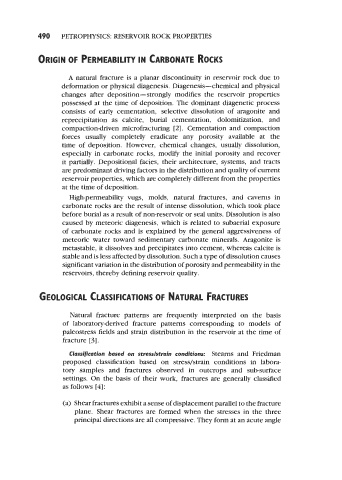Page 522 - Petrophysics
P. 522
490 PETROPHYSICS: RESERVOIR ROCK PROPERTIES
ORIGIN OF PERMEABILITY CARBONATE ROCKS
IN
A natural fracture is a planar discontinuity in reservoir rock due to
deformation or physical diagenesis. Diagenesis-chemical and physical
changes after deposition-strongly modifies the reservoir properties
possessed at the time of deposition. The dominant diagenetic process
consists of early cementation, selective dissolution of aragonite and
reprecipitation as calcite, burial cementation, dolomitization, and
compactiondriven microfracturing [ 21. Cementation and compaction
forces usually completely eradicate any porosity available at the
time of deposition. However, chemical changes, usually dissolution,
especially in carbonate rocks, mod* the initial porosity and recover
it partially. Depositional facies, their architecture, systems, and tracts
are predominant driving factors in the distribution and quality of current
reservoir properties, which are completely different from the properties
at the time of deposition.
High-permeability vugs, molds, natural fractures, and caverns in
carbonate rocks are the result of intense dissolution, which took place
before burial as a result of non-reservoir or seal units. Dissolution is also
caused by meteoric diagenesis, which is related to subaerial exposure
of carbonate rocks and is explained by the general aggressiveness of
meteoric water toward sedimentary carbonate minerals. Aragonite is
metastable, it dissolves and precipitates into cement, whereas calcite is
stable and is less affected by dissolution. Such a type of dissolution causes
significant variation in the distribution of porosity and permeability in the
reservoirs, thereby defining reservoir quality.
GEOLOGICAL CLASSIFICATIONS OF NATURAL FRACTURES
Natural fracture patterns are frequently interpreted on the basis
of laboratory-derived fracture patterns corresponding to models of
paleostress fields and strain distribution in the reservoir at the time of
fracture [ 31.
Classification based on stresslstrain conditions: Stearns and Friedman
proposed classification based on stresshtrain conditions in labora-
tory samples and fractures observed in outcrops and subsurface
settings. On the basis of their work, fractures are generally classified
as follows [4] :
(a) Shear fractures exhibit a sense of displacement parallel to the fracture
plane. Shear fractures are formed when the stresses in the three
principal directions are all compressive. They form at an acute angle

